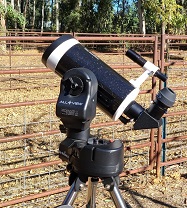A couple of years ago I decided that it would be fun to have a simple telescope so I could share a bit of my delight about astronomy with my grandsons. In the “way back time” (when I was a young man) I taught introductory astronomy at Humboldt State University in Arcata, California. At that time I had ready access to many small (up to 12″) telescopes on a variety of mounts.

The university had an actual (albeit very small) observatory, with domed buildings and all that. I really enjoyed that job,especially spending time on the mountain with students learning a little bit about the stars, constellations and ancient myths. One young lady from southern California exclaimed that she was really excited to use a telescope because she had always wanted to see a star and she thought they were only visible through a telescope! (She had never been anyplace where you could just look up and see the stars in the sky.)
Being an introductory class, it was really just a group of amateurs doing live observations with amateur sized instruments, we did almost no work with cameras or other instruments. I soon realized that once you have observed a few dozen objects with a small telescope you were kind of out of new things to see. The highlights consist of the moon, the sun (through an appropriate filter), the planets and most of the Messier list of nebula. The Messier list consists of “fuzzy” objects that Charles Messier cataloged so that he won’t keep getting distracted by them. He used a 100mm telescope, which is close in size to the 117mm one I picked out – so I hope that I can easily find most of these objects over the course of a year or so. Now and then a comet or an eclipse comes along, but other than that you are pretty much out of interesting things to see without moving on to more sophisticated techniques such as photography or using various types of instruments.
Because I had the opportunity to use the university’s telescopes for several years, I didn’t have much interest in going to all of the trouble, and expense, of having my own. However, having grandchildren around rekindled the feeling of awe at seeing some of the more spectacular sights.
I decided to get a small, inexpensive, Maksutov-Cassegrain telescope along with a computerized mount to assist in finding objects quickly while being distracted by people eager to see the “next thing” on the list. I ended up selecting a simple 117mm SkyWatcher “Mak” telescope mounted on a Celestron “All View” mount. Unfortunately, when I went to join the two I discovered that while it all fit together, it ended up with the telescope being “up-side-down” (which means it points in the wrong direction on the mount). I hadn’t accounted for this problem, but the result is that the spotting scope ends up on the bottom of the telescope tube where it is almost impossible to access. I decided that the solution was going to be drilling and tapping holes on the top side so I could mount the spotting scope on top where it is more easily accessible. But then “things” got in the way and I set that project aside for awhile, then covid-19 came along, therefore I lost ready access to my grandsons, and … and .. The short story is that I still haven’t fixed the problem
Because of the “excitement” about Jupiter and Saturn being in conjunction on the solstice this year, and the situation where Saturn’s rings are tilted so we can see them more easily, I decided to try again. I decided to try just putting the telescope on the mount so that the spotting scope is on top. This results in having to install it on the outboard side of the mount (see photo), meaning that the azimuth controls run reverse from what they normally do. I am wondering if the computer will even notice that it is backwards. My guess is that after I set it up it will just point to where it is aimed and that will be the end of the problem. Last night was going to be the test of my theory, but it was cloudy. The storm as passed and perhaps it will be clear this evening. If so, I am going hunting for Saturn in the early evening before it sets shortly after nightfall. I am excited to finally get a chance to look through the eyepiece at what I consider one of the best “amateur” objects of all.
Charlie,
Thanks for the reminder that the two planets will be worth observing on Dec 21. My guess is that I need a clear view of the western sky and that a good time to view will be right after dust.